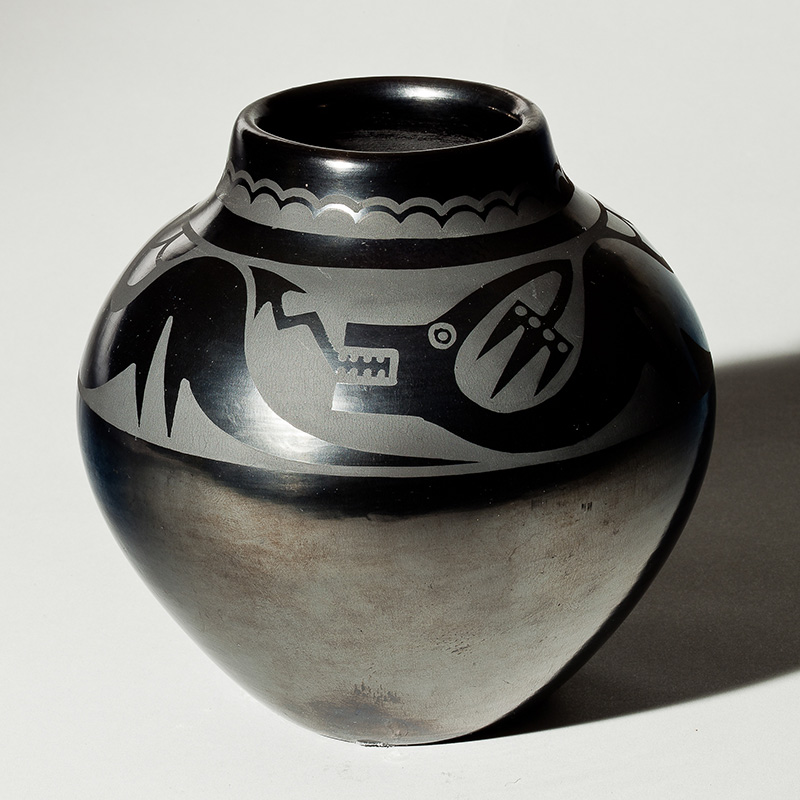
| Maker | Maria Montoya Martinez (San Ildefonso Pueblo, New Mexico 1881/1885–1980; and Popovi Da Martinez (San Ildefonso Pueblo 1923–71) |
| Date of Creation | n.d., likely 1920s–50s |
| Location | San Ildefonso Pueblo, New Mexico |
| Materials | Pinch and coil construction burnished black on black ceramic bowl |
| Institution | Swope Art Museum |
| Credit Line | Museum purchase with funds from the Hulman gift |
| Accession Number | 1967.032 |
| Photo Credit | Swope Art Museum |
A small, elegantly formed black pot reflects its surroundings like a dark mirror. Above the midline, an undulating serpent encircles the shoulders of the vessel, its shiny form made visible by contrast with a flat, meticulously applied slip in the negative spaces. Scalloped shapes evoke a scaly snakeskin in lunettes above its sinuous form. The same motif is flipped and connected to create a continuous band of cloud-like shapes around the neck of the vase. An arrow darts from the creature’s open mouth, while a trident appears to spring from the back of its head; its deadly tines coiled and ready to jab. A single eye stares out at us.
Maria Martinez is credited with the revival of Pueblo pottery in the American Southwest. Maria and her husband, Julian (1879–1943), lived and worked at San Ildefonso Pueblo in New Mexico, where they maintained strong ties with their Tewa Indian heritage. In Tewa pottery-making traditions, women are responsible for construction and for the finishing touches, while men assist in gathering the raw clay and paint the designs on the finished vessels. Many of their motifs are geometric, influenced by ancient pottery shards from locally excavated sites, thereby providing a visual continuity to the past.
The creation of pottery in the pueblos is as much a way of life as a creative expression. Most potters, like Maria, see themselves as part of the earth or clay that they use to form their vessels. Commercial glazes and kilns are rejected for traditional coil construction, open pit firing and hand decoration, which trace back more than two thousand years to their Anasazi ancestors. Maria created her pots by mixing clay with volcanic ash found on her pueblo and built her forms using the coil method. Once the basic shape was completed, she then scraped and smoothed the coils with a gourd tool, then polished the surface with a stone after the clay had dried to a leather-hardness.
Ancient pottery designs inspired Julian Martinez, who began by painting Maria’s pieces. In the early 1920s, he transitioned from a polychrome style to a black-on-black technique. The painted areas were matte-black while the unpainted area remained polished. Maria and Julian’s pots attest to the durability both of their artistic work and their cultural traditions. Their high standards of excellence helped to inspire others and awaken the world to the beauty of Pueblo pottery.

